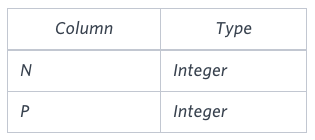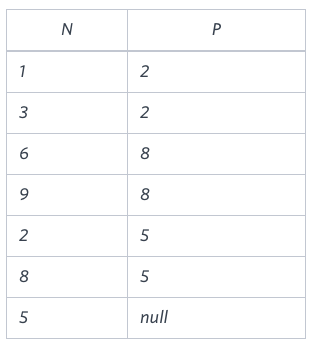반응형

You are given a table, BST, containing two columns: N and P, where Nrepresents the value of a node in Binary Tree, and P is the parent of N.

Write a query to find the node type of Binary Tree ordered by the value of the node. Output one of the following for each node:
- Root: If node is root node.
- Leaf: If node is leaf node.
- Inner: If node is neither root nor leaf node.
Sample Input

Explanation
The Binary Tree below illustrates the sample:

BST라는 이진 트리 테이블이 주어졌을 때, 각 노드가 Root, Inner, 또는 Leaf 중 어떤 유형에 해당하는지를 판별하는 SQL 쿼리를 작성하고, 그 논리를 쉽게 설명드리겠습니다.
BST 테이블에는 다음과 같은 두 개의 컬럼이 존재합니다:
- N: 현재 노드의 값
- P: 해당 노드의 부모 노드 값 (루트 노드의 경우 NULL)
우리는 각 노드를 다음 세 가지 유형 중 하나로 분류하고자 합니다:
- Root: 부모가 없는 노드 (P IS NULL)
- Leaf: 자식이 없는 노드
- Inner: 부모도 있고 자식도 있는 노드
select N,
case
when p is null then 'Root'
when n not in (select distinct p from bst where p is not null) then 'Leaf'
else 'Inner'
end as nodetype
from bst
order by n;- P IS NULL인 경우 → Root: 부모 노드가 없으므로 루트입니다.
- 현재 노드 N이 다른 노드의 부모(P)가 아닌 경우 → Leaf: 즉, 어떤 노드의 부모로 등장하지 않는다면 자식이 없다는 의미입니다.
- 그 외의 경우 → Inner: 부모도 있고 자식도 있는 노드입니다.
반응형
'Computer Science > SQL' 카테고리의 다른 글
| SQL | HackerRank ROW_NUMBER()와 COUNT(*) OVER()를 활용하여 중앙값(Median) 구하기 (0) | 2025.06.18 |
|---|---|
| SQL | HackerRank 평균 오차 구하기 (Replace) (0) | 2025.06.17 |
| SQL | HackerRank MAX(CASE WHEN…)을 활용한 피벗(Pivot) 쿼리 (0) | 2025.06.15 |
| SQL | HackerRank 문자열을 이어붙이기 (CONCAT) (0) | 2025.06.14 |
| SQL | HackerRank 정규표현식으로 도시 찾기 – DISTINCT와 REGEXP 활용 (0) | 2025.06.13 |